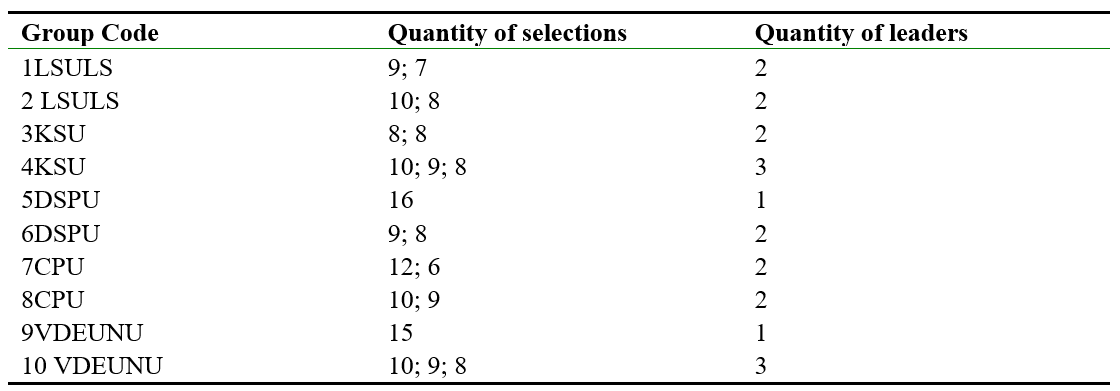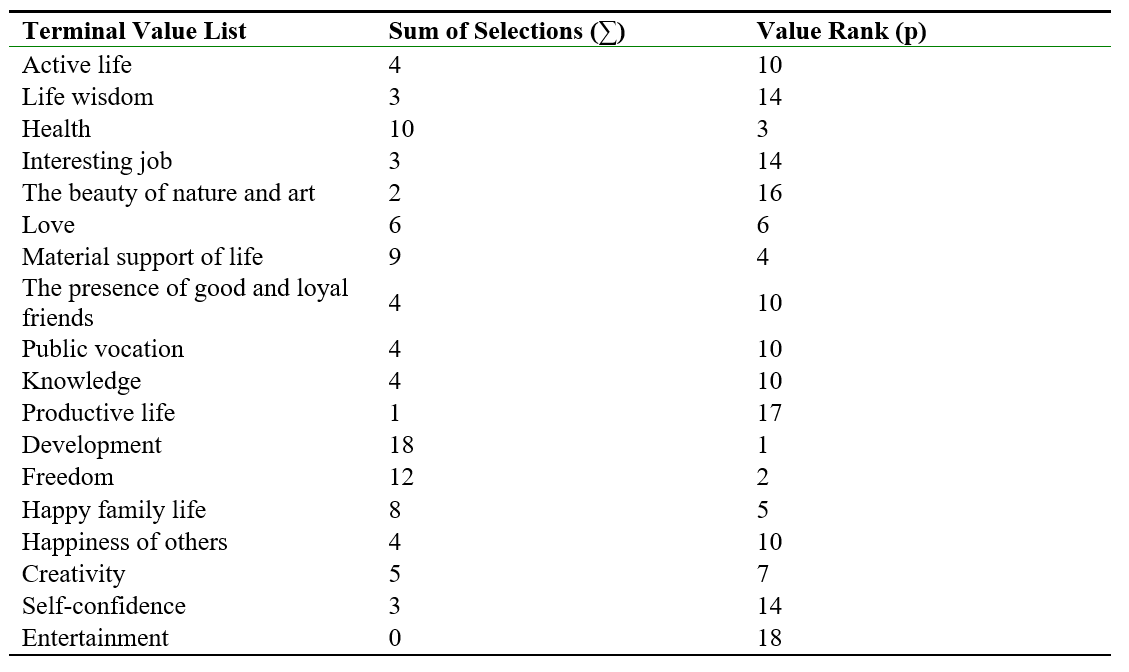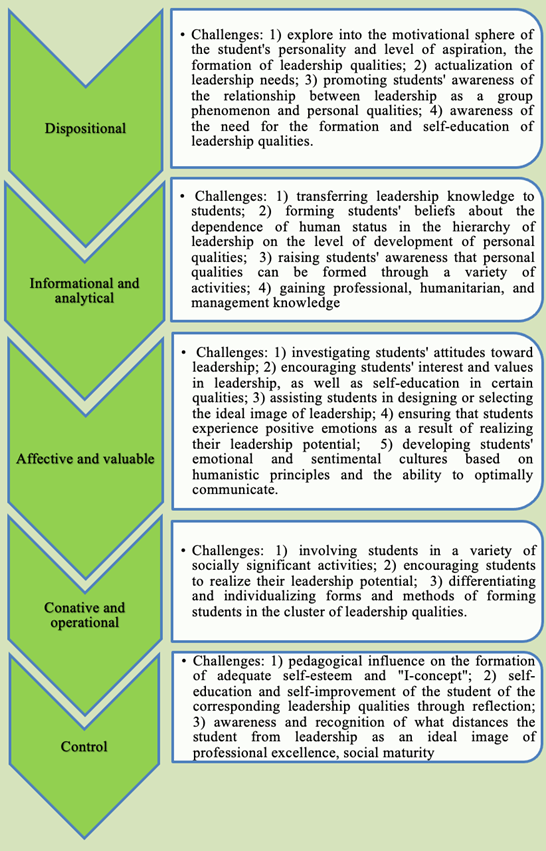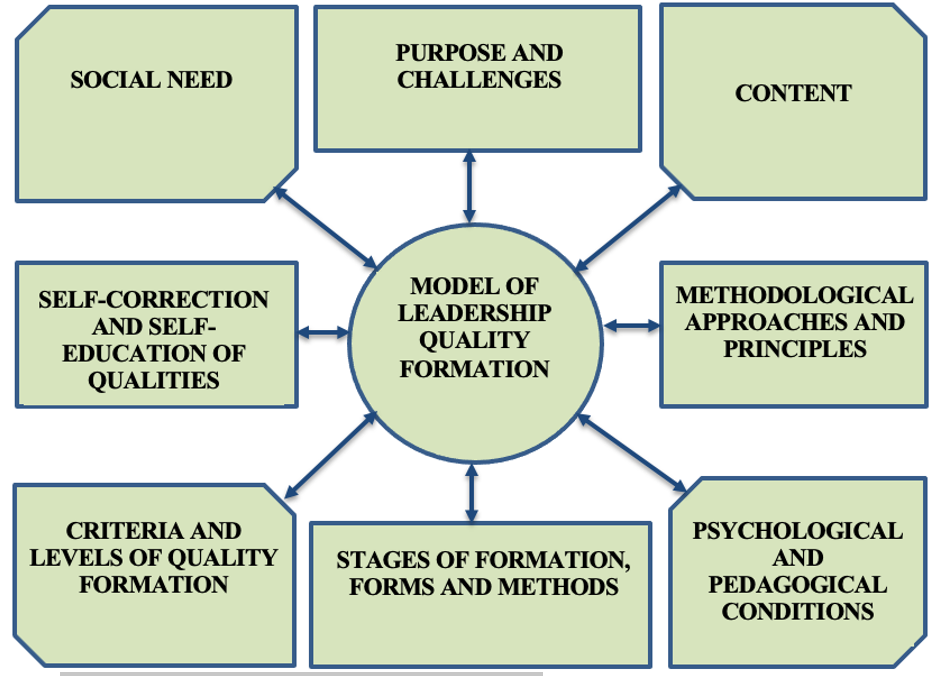DOI:https://doi.org/10.34069/AI/2022.51.03.4
Empirical research of student leadership’s content parameters
Емпіричне дослідження змістових параметрів студентського лідерства
Abstract
The aim of this article was to perform a retrospective analysis and generalization of the content parameters of student leadership through an empirical study. Sociometric method and psychodiagnostic instruments were used to establish the values of student group leaders. Significant correlations between the studied leadership parameters were found. The sociometric status of student leaders was determined and their values were clarified. The stages and challenges of forming student leadership qualities were outlined. The model of the development of student leadership qualities was graphically constructed and substantiated. It was generalized that the empirical study of the content parameters of student leadership contains significant scientific facts that should be implemented in the educational process; the data can be useful to university administrations and student group curators.
Keywords: student group, educational process, terminal values, instrumental values, motivation.
Анотація
Метою статті є ретроспективне аналізування та узагальнення з емпіричним дослідженням змістових параметрів студентського лідерства. Застосовано соціометричну методику і псих діагностичний інструментарій для встановлення цінностей лідерів студентської групи. З’ясовано значущі кореляційні зв’язки між досліджуваними параметрами лідерства. Визначено соціометричний статус студентських лідерів і з’ясовано їхні цінності. Встановлено і обґрунтовано кореляційні зв’язки соціометричного статусу студентських лідерів з цінностями “Розвиток” (р < .01) і “Сміливість у відстоюванні своєї думки, поглядів” (р < .01); соціометричного статусу усіх респондентів з цінностями “Наявність хороших і вірних друзів” (р < .05) і “Незалежність” (р < .05). Окреслено етапи та завдання формування лідерських якостей студента. Графічно побудовано і обґрунтовано модель формування лідерських якостей студента. Узагальнено, що емпіричне дослідження змістових параметрів студентського лідерства містить важливі наукові факти, які доцільно операціоналізувати у освітній процес; дані можуть бути корисні адміністраціям університетів, кураторам студентських груп.
Ключові слова: студентська група, освітній процес, термінальні цінності, інструментальні цінності, мотивація.
Introduction
The problem of leadership is directly related to the world’s acute sociopolitical and economic difficulties, and it necessitates competent, professionally, morally mature, and trustable individuals. Some scientists believe that such people are the most politically aware, intellectually, morally, and ethically developed, capable of solving any complex problem and building a new life through a creative understanding of the world and humanity’s needs (Meneghetti, 2004; Sopovnik, 2012). The COVID-19 pandemic adjusted this scientific problem significantly, increasing young people’s existential anxiety (Popovych et al., 2020a), altering spatial regulation of behavior (Khmiliar et al., 2020), and creating favorable conditions for leisure and free time on social media (Hudimova, 2021a; 2021b; Hudimova et al., 2021). The consequences of the COVID-19 pandemic are still being studied, particularly the effectiveness of the educational process, which has undergone significant changes due to distance learning. This articulation of research issues focuses on young people’s social expectations and perceptions of their psychological well-being (Ma et al., 2020; Shevchenko, 2019).
At the current stage of society’s development, the issue of forming organizational leaders is being studied in pedagogical (Shevchenko et al., 2020a; 2020b; Sopovnik, 2012), psychological (Blynova et al., 2020b), and social dimensions (Popovych et al., 2021b). Universities are undergoing significant transformations, including globalization (aggregation), pragmatization, standardization, and marketing, according to investigation (Serkina & Logvinova, 2019). All of these transformational changes require critical thinking (Arbeláez-Campillo et al., 2020) and appropriate application. The problem of leadership in the student group is still relevant. A leadership position is distinguished by a responsible attitude toward themself, other members of the group, nature, and the world, as well as a willingness to accept responsibility for solving urgent tasks. The formation of a leader is one aspect of the formation of a national elite in any nation.
Leadership is a personalized form of social control that incorporates all mechanisms and methods of socio-psychological influence to achieve maximum effect in group activities and communication (Klenina, 2019). The following qualities must be owned by the headmaster in order to successfully lead a student group: responsibility; communicative abilities – sociability, namely the ability to establish and maintain contacts with all members of the group, sincerity, willingness to communicate, critical ability to defend their views; s tress resistance refers to the ability to withstand a variety of extreme influences; adaptive mobility – the operation of a purposeful system determined by the correspondence of goals and achievements in the course of activity; organizational skills include self-control, assertiveness, and organization (Zanyuk, 2002).
Researchers are particularly interested in motivation and the development of leadership qualities (Pinkovetskaia et al., 2020). It is important that the leader is able to lead. As a result, subordinates look up to such a leader as an ideal role model and admire them. Leadership skills and inspiring motivation, according to S. Zanyuk (2002), are components of a transformational leader’s charisma. Personal attention to each subordinate is critical to ensuring the overall effectiveness of the team and the high productivity of each individual. When a leader encourages subordinates to be innovative and creative, intellectual stimulation occurs. A transformational leader may appear ‘soft’ and liberal at first glance, but in reality they are a role model, constantly improving oneself and encouraging subordinates to develop themselves (Zanyuk, 2002).
A leader is a person by whom all other members of the group recognize the right to make the most responsible decisions that affect their interests and to determine the direction and nature of the activities of the whole group (Meneghetti, 2004). The effective functioning of the group is primarily dependent on the relationship that develops between the group’s formal leader and informal leaders. Knowledge about the group’s actual interpersonal relationships allows the teacher to guide them in the right pedagogical direction. The group leader, on the other hand, is capable of assisting the teacher in the teaching and educational process based on business and personal qualities. An experimental study showing that cooperation between students with high levels of leadership qualities and students with low levels of leadership qualities does not produce positive results is scientifically interesting. Concurrently, collaboration with university teachers aims to support participating students and promotes the development of leadership skills (Zorina et al., 2018).
Leadership is the process of internal social organization and communication management that is carried out by members of a small group in spontaneously formed small groups. Most researchers agree that leadership is a changing phenomenon that is closely related to the overall gradual development of the group, as well as the dynamics of the most important areas of its life (Shamir & Eilam, 2005). For example, R. Krichevsky’s (2007) leadership theoretical model incorporates the concept of psychological ‘value’ exchange between group members in their interpersonal interactions. It is assumed that the value characteristics of individuals, namely the individual’s significant characteristics, orientation, skills, experience, and so on, appear to be exchanged for the group’s authority and recognition (Krichevsky, 2007).
Retrospective analysis reveals that the time of studenthood is youth, which marks the end of the transition period from childhood to adulthood, i. e. entering the adult world. There are significant psychological changes at this age (18-23 years): self-development is activated, conscious self-improvement is actualized, and moral and aesthetic feelings acquire active development. Character traits are being formed and stabilized, and most importantly, a person of this age is mastering a new adult role repertoire. This repertoire of roles can include civic, sociopolitical, professional, labor, and family roles (Popovych et al., 2020b; 2021c).
Under the psychological content parameters of student leadership, we mean a set of characteristics and psychodiagnostic dimensions (for example, sociometric status) that can accurately reflect the phenomenon of student leadership.
A retrospective analysis of the scientific literature led to the conclusion that the ongoing global transformations, such as humanity’s fight against the pandemic COVID-19, have had an impact on social reality and the phenomenon of student leadership. This issue requires immediate attention as well as a modern scientific perspective on today’s realities.
Hypothesis. We assume that the findings of the empirical study of the content parameters of student leadership will contain important scientific facts, and that the findings should be implemented in the educational process.
The aim of the article is to retrospectively analyze and generalize with further empirical study of the content parameters of student leadership.
Methodology and methods
The methodology of our empirical study was based on the interpretation that it is possible to establish the urgency of the problem, clarify correlations, and interpret the phenomenon through psychodiagnostic measurement of content parameters that relevantly reflect the studied phenomenon. Researchers’ perspectives are taken into account in adaptation processes (Blynova et al., 2020a), time perspective research (Plokhikh et al., 2021; Popovych et al., 2021a), and studies of other activities related to the current one (Nosov et al., 2020; Zinchenko et al., 2020).
Participants. The sample was selected at random and included students from a variety of Ukrainian universities: Institute of Psychology and Social Protection Lviv State University of Life Safety (Lviv, Ukraine) (n=44); Kherson State University (Kherson, Ukraine) (n=32); Horlivka Institute for Foreign Languages of the State Higher Educational Establishment “Donbas State Pedagogical University” (Bakhmut, Ukraine) (n=32); Classical Private University (Zaporizhzhia, Ukraine) (n=23); Volodymyr Dahl East Ukrainian National University (Severodonetsk, Ukraine) (n=49). Students ranged in age from 18 to 25 years. Students with different social and family status, different wealth and with different professional experience. Classical, branch, state and private institutions of higher education are presented. The total number of participants was 180, of whom males (37.78; n = 68) and females (62.22; n = 112). The average age of the participants was M = 19.34.
Organization of Research. A statement section of the study and data interpretation were made in 2021, specifically from February to April, and then continued from October to November. The study included ten student groups from five different universities. Moreno’s (1958) sociometry was used. The respondents’ sociometric status was assessed, the sociogram and sociomatrix were created, and the sociometric index was calculated. A simulated current situation in student life, allowing respondents to consider their selections thoroughly and thoughtfully.
The value orientations of all respondents were determined using the “Study of Personality Value Orientations” (Rokeach, 1979) method. There were eighteen terminal values and eighteen instrumental values on the list of value orientations. Each respondent chose five values from each of the two forms voluntarily. The values chosen most accurately reflect the respondent’s position in student life, particularly in the student group.
Statistical Analysis. The statistical software package “SPSS” version 23 was used. The Spearman coefficient (rs) was used to record correlation relationships. The obtained data was ranked according to MS “Excel”. The reliability parameters that were at the level not lower than p≤.05 were taken into account. The modeling method (Shtoff, 1966) was used to develop an empirical model of student leadership qualities.
Results and discussion
Sociogram and sociomatrix using the “Sociometry” method (Moreno, 1958) were constructed. The selections of respondents enabled the measurement of sociometric status and the calculation of a sociometric index.
In Table 1, we present the findings of the study using the “Sociometry” method.
Table 1.
The results of the study according to the “Sociometry” method (n=180)

According to the results of the “Sociometry” method, there were twenty leaders in ten student groups. There were two leaders in six groups, three leaders in two groups, and one leader in the final two groups. Sociometric method has allowed us to focus on leaders.
So let highlight the findings of the “Study of Personality Value Orientations” method (Rokeach, 1979). We present the sum of selections and the rank of terminal values of student leaders in Tabl. 2.
Table 2.
The results of the study of terminal values of student leaders according to the “Study of Personality Value Orientations” method (n=20)

Student leaders showed the following importance of the ranks of terminal values: 1) “Development” (∑=18; p=1); 2) “Freedom” (∑=12; p=2); 3) “Health” (∑=10; p=3); 4) “Material support of life” (∑=9; p=4) and “Happy family life” (∑=8; p=5). The student sample had slightly different results of the significance of the ranks of terminal values: 1) “The presence of good and loyal friends” (∑=225; p=1); 2) “Material support of life” (∑=214; p=2); 3) “Health” (∑=210; p=3); 4) “Love” (∑=201; p=4) and “Entertainment” (∑=188; p=5). The results of the study of values and psychological well-being, particularly in the student sample, were consistent with the findings of the study of values and psychological well-being in youth (Semenov et al., 2021). Along with development, hedonistic values had a place in this study. This combination is quite common in our society, as we are forced to admit that hedonistic orientation and consumer philosophy are frequently prevalent among young people.
The amount of selections and the rank of instrumental values of student leaders were determined by the “Study of Personality Value Orientations” method (Rokeach, 1979). Tabl. 3 presents the results.
Table 3.
The results of the study of instrumental values of student leaders according to the method “Study of Personality Value Orientations” method (n=20)

Student leaders showed the following significance of instrumental values: 1) “Courage in defending one’s thoughts and views” (∑=17; p=1); 2) “Education” (∑=14; p=2); 3) “Liberality” (∑=11; p=3); 4) “Mannerliness” (∑=9; p=4) and “Accuracy” (∑=8; p=5). The general student sample showed the following significance of the ranks of instrumental values:1) “Independence” (∑=221; p=1); 2) “Liberality” (∑=215; p=2); 3) “High requests” (∑=193; p=3); 4) “Courage in defending one’s thoughts and views” (∑=190; p=4); 5) “Education” (∑=189; p=5). The top five instrumental values of student leaders and the general sample differed little, except for the ranking. This suggests that instrumental values, as opposed to terminal values (Rokeach, 1979), have a higher assimilation ability and have a significant impact on the formation of a young personality.
The main findings of Spearman (rs) correlation analysis were outlined. According to the findings, there was a significant positive correlation between sociometric status and the terminal value “The presence of good and loyal friends” (.233; р < .05) and the instrumental value “Independence” (.244; р < .05) in the student sample. There was a significant positive correlation of sociometric status with the terminal value “Development” (.333; р < .01) and the instrumental value “Courage in defending one’s thoughts and views” (.214; р < .05) in the sample of student leaders. The dominance of psychological determinants of youth development, conscious civic position, elements of maximalism, and the desire for a quick result were used to explain the obtained results.
The results of the retrospective analysis and empirical study of psychological content features of student leadership enabled us to move on to highlight the stages and objectives of leadership development and to create an empirical model of student leadership qualities.
The first stage of modeling considers the preliminary analysis of students’ development of leadership qualities, revealing the role and place of various subjects in the educational process. The following pedagogical conditions were supported: theoretical preparation of students in leadership studies, motivation of students for leadership, readiness to form students’ leadership qualities, formation of public opinion stimulating students’ leadership behavior, favorable moral and psychological climate and creative atmosphere, development of effective forms of student self-government taking into account the students’ ages and individual characteristics (Sopovnik, 2012).
The models of student leadership development found in the psychological and pedagogical literature were examined in the second stage of modeling (Semenov et al., 2021; Sopovnik, 2012). The following components of the model of leadership quality formation in university students were identified by the authors: social need; purpose and objectives; content; methodological approaches and principles; pedagogical conditions; stages of formation; forms and methods, criteria, indicators, and levels of leadership qualities; self-diagnosis, self-correction, and self-education of qualities. The public need requires professionals who are educated in civic values, capable of acting effectively in uncertain situations, being creative in solving pressing problems, producing new ideas, uniting people around a socially useful goal, and ensuring its achievement in the shortest possible time at the lowest possible cost. The model’s goal was to foster the development and self-education of a specific set of leadership qualities. In the quality structure, we emphasized the need to behave, act in a specific range of situations, which was also dependent on the cognitive, emotional, and value spheres of personality. In view of this, we proposed five stages of leadership development, which are based on a review of the scientific literature and supplemented by our own research on the phenomenon of student leadership (Krichevsky, 2007; Sopovnik, 2012): 1) dispositional; 2) informational and analytical; 3) affective and valueable; 4) conative and operational; and 5) control.
Figure 1 illustrates the stages and challenges involved in developing a student’s leadership abilities, as well as the content of these challenges.

Figure 1. Stages and challenges of forming student leadership qualities.
The model of student leadership qualities development (Fig. 2) is a complex structural formation, a system with interconnected components that determine its integrity and effectiveness.

Figure 2. Model of formation of student leadership qualities.
The proposed model’s components are the result of a review of the scientific literature and its interpretation (Krichevsky, 2007; Sopovnik, 2012): social need; purpose and objectives; content; methodological approaches and principles; psychological and pedagogical conditions; stages of formation, forms, and methods; leadership development criteria and levels; self-diagnosis, self-correction, and self-education of qualities.
The implementation of the student’s stages and challenges for developing leadership qualities must be considered in conjunction with the components of the model for developing leadership qualities. As a result, the informational and analytical stage enables to concentrate on the development of intelligence, professional knowledge, the ability to anticipate and evaluate changing natural factors, environmental culture, and creativity. Morality and empathy are examples of affective and valueable behaviors. The conative and operational stage entails the application of leadership qualities in practice, as well as their verification and correction at the control stage of the self-education process. The actual directions for further development of the outlined problem are the substantiation of features and methods of forming separately taken leadership qualities of students.
Conclusions
- We state that under the psychological content parameters of student leadership we understand a set of qualities and psychodiagnostic dimensions that were able to relevantly reflect the phenomenon of student leadership.
- The terminal values “Development” (∑=18; p=1) and “Freedom” (∑=12; p=2) were found to be important for student leaders. The terminal values in the student sample were “The presence of good and loyal friends” (∑=225; p=1) and “Material support of life” (∑=214; p=2).
- It has been established that the results of prevailing terminal values, particularly in the student sample, are quite typical for our society, as we are forced to admit that the hedonistic orientation and consumer philosophy of young people frequently prevail.
- The instrumental values “Courage in defending one’s thoughts and views” (∑=17; p=1) and “Education” (∑=14; p=2) were found to be important for student leaders. The instrumental values in the student sample were “Independence” (∑=221; p=1) and “Liberality” (∑=215; p=2).
- The stages and challenges of developing leadership qualities were outlined, and a student’s model of forming leadership qualities was graphically constructed and substantiated.
- It is substantiated that the obtained results of empirical research on psychological content parameters of student leadership contain significant scientific facts and that they should be implemented into the educational process.
